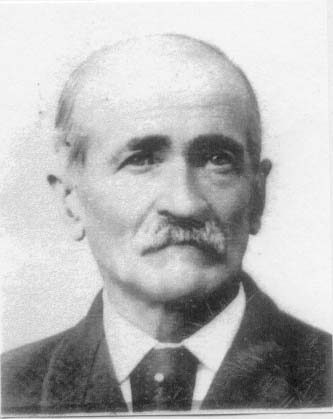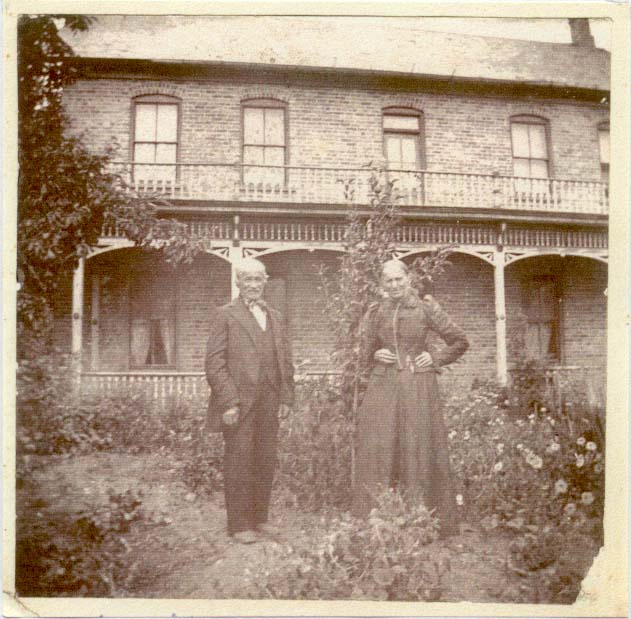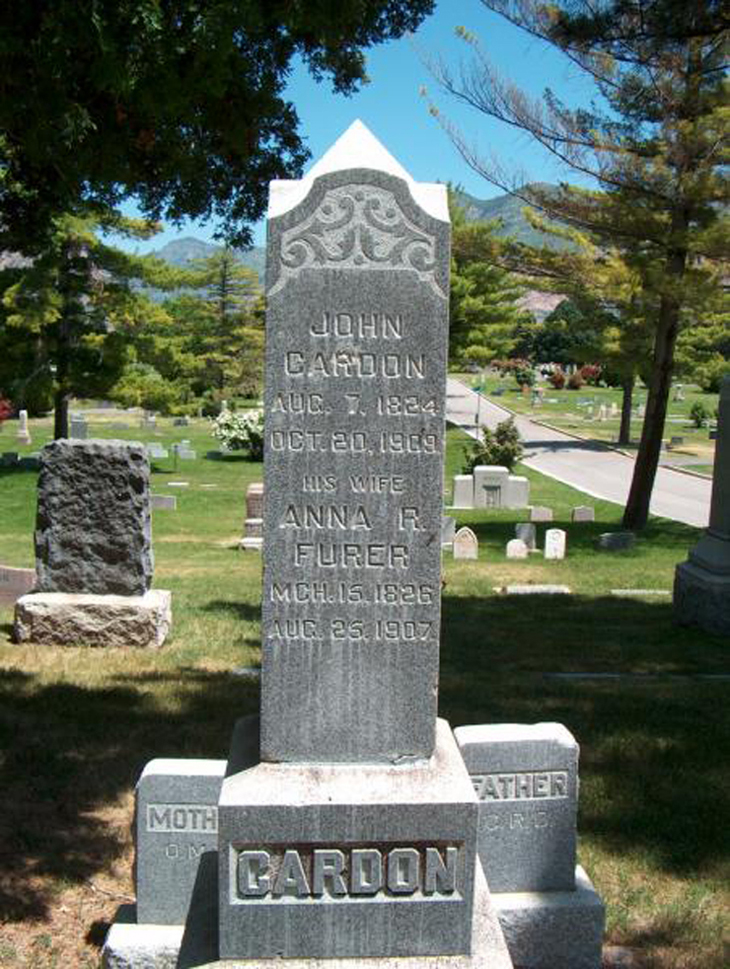7 Aug 1824 – 20 Oct 1909
Son of Philip Cardon and Martha Marie Tourn

Jean Cardon, the second child of a family of nine, was born on 7 August, 1824 in Prarustin, Piedmont, (also referred to as Prarostino, Torino) Italy to Philippe Cardon and Marthe Marie Tourn. His parents were Waldensians who, with six of their children, joined the Church of Jesus Christ of Latter-Day Saints in 1852 and emigrated from their home in the Piedmont Valleys in 1854, arriving in Utah in September of that same year. From that time on, the immigrant, Jean Cardon, would be know as John Cardon.
Memories of his life, up to the time of his marriage to Anna Furrer in October of 1854, are described in his own words, as recorded on pages 65 and 66 of the Family Record Book, originally in the possession of his eldest daughter, Anna Rosina Cardon Shaw. This record (with editing of spelling only) is attached as Appendix 1.
John and Anna, following their marriage, first lived in Big Cottonwood until 1857, before moving to Marriott Settlement, Weber County where they lived on a small farm until March of 1863, except for a short time in 1858 during the “Move South to Lehi at the time Johnston’s Army entered Utah Territory. During their stay in Marriott, they remembered the flooding of the Ogden River, when Anna and her three small children had to be rescued by neighbors from a nearby haystack where they had taken refuge during the flood.
In 1863, John and Anna and their four children moved near Bingham Fort, at that time north of the Ogden City limits. John built a log cabin for his family at 507 Washington Avenue and, later in 1866, a rock house at that location. Beginning in 1863, John and Anna managed a general merchandise store at 503 Washington Ave. They also built, adjacent to their home, the first carding mill in Weber County. To supply power for the Mill, a ditch was dug by hand by John and his hired man to take water out of the Ogden River near 1251 Canyon Road. This ditch later became the Lynne Irrigation Canal for that area. John made the water wheel, tables and pickers of native lumber. The iron used in the machinery was brought from the East by ox team. After the mill was completed, John and his wife Anna did all the carding at night after the farm work was finished. The wool was made into batts or quilts and rolls from which yarn was made. These batts and rolls were held or pinned together with thorns from Hawthorne bushes. Wool was brought to this mill from all over Weber and Cache Counties. Cardons received their pay in produce. After operating for about 15 years, the mill was sold and taken to Southern Utah.
During this period, John applied for and received his Certificate of Citizenship, Territory of Utah, United States of America, on 24 July 1876.
After sale of the carding mill in 1879, John and Anna moved to Franklin, Idaho where they managed a farm and a mercantile store. Later, they moved to Blackfoot, Idaho where they again built and operated a general merchandise store. Their fortitude was sorely tested when the store was burned down, but they rebuilt and continued operating their business. In 1882, while living in Blackfoot, they adopted a baby girl, Edna May, who was later sealed to them.
In 1885, they returned to Ogden. In June of 1886, their barn and house were set on fire by a disgruntled farmhand whom Anna had discharged. The barn, several horses, all of their farm equipment, hay and tools were destroyed. The home was also badly burned. In 1887, John built a 2-story brick house at the same location as the former rock house. It became known as the Big House. At that time, it was unusual in that it had double porches (ground level and second level above) on the East and South sides. In addition, a storage basement was provided with stonework arches for proper support of the house above. Most of the work, especially the finish work, was done by John. He even crafted his own tools. His original wood joiner plane and dado plane may be viewed today at a great-grandson’s workshop. A photo of John and Anna standing in front of this home at 507 Washington Blvd. is attached. Many other families shared occupancy of this house until John’s death in 1909. His wife Anna had died earlier in August 1907.
John Cardon’s obituary appeared in the Ogden Standard Examiner on 21 October 1909, the day following his sudden attack of apoplexy at the home of his daughter, Mrs. Charles Drumiler, 507 Washington Avenue, Ogden, Utah. “He was identified with the early building of the city and was always known to be a man of the highest integrity and frugality. A builder by trade, he managed the construction of many houses in the northern part of the city. He was also a member of the High Priests Quorum of the North Weber Stake. His funeral was held in the Lynne Ward meeting house, with Bishop Turnquist presiding. Interment was in the Ogden City Cemetery.
APPENDIX I
Autobiography of John Cardon (1824-1909)
(Jean) John Cardon.
Born August 7 in year 1824 on a mountain forest, northeast side of south Alps. A large river at foot of mountain. County name, Prarustin. At the age of 7 or 8 years I moved a little farther north, with my father’s family. My brother, Bearthelemy [Barthelemil, who was sick at that time, I carried from our forest home, Prarustin, to Bulcosta, a distance of a mile and a half. My brother died when about 5 years of age. My father’s family consisted of father, Philippe Cardon, mother, Martha Marie Tourn, children, Anneta, John, Barthelemy, Cathrin, Louise, who died when 2 years of age, Philippe, Magdlen Marie [Mary Guild as she is now called], John Paul, Thomas Bartholemi. From Bulcosta we again moved three miles further. This place was called Bria. We stayed there about 15 years. County of Neridor? My father and his sons were stone masons builders or mechanics, working 18 hours a day, except the month of May, we devoted to raising silk. The whole family started for America except my sister Annetta, being married did not want to come. We started for America on Jun 11 1854. We were 45 days in crossing the ocean. Landed at New Orleans, then by steam boat 11 days to St. Louis. My father was very sick and began to be discouraged. He was 8 days under quarantine. 25 young men left steam boat 20 miles before we got to St. Louis in order not to be quarantined. Next took steamer to Kansas, was 4 days. Here we stayed for 5 weeks. About July we started for Utah with wagons and oxens. I drove a yoke of oxen for Charles Desole. Walked across the plains. Arrived in Salt Lake City on Oct 31 [Oct 28], 1854. On the journey seven yoke of oxen cattle and 3 wagons run over me. I was administered to and in a week, I was again able to drive. Mrs. DeSole, being very domineering, I was always the first to have my yoke of oxen ready and then ready to assist others. We were in Robert Campbell’s Emigrants Company, there being 35 wagons. Came from Salt Lake City to Ogden City. Camped on north comer of Farrell Subdivision near where Tenth Street is, west side of road. Lived until 12 of March, 1855 with my father’s family. I learned to be a cooper. I made chairs and buckets, wood washboards out of Boxelder trees and sold them to maintain my father’s family thru the winter. On the 12th of March I entered a contract with Fredrick Lobae at Salt Lake City, Utah to manufacture Saltrates. Made a large quantity of saltpeater. Distilled potatoes and made alcohol. Distilled beet molasses and made for sugar. Then went up in Cedar Mountain 35 miles east of Salt Lake. Distilled sugar pine or pitch pine to manufacture rosin, pitch, tar, turpentine. Later became dissatisfied with the Church. I then worked building at Big Cottonwood. I then became acquainted with Anna Raglea Furrer. I went to get my pay for some cooper work I done for a lady where she stayed, who tried to make the match or introduced us and neither of us had met before. Still at last consulting the counseling of Brigham Young. He then counseled Anna Raglea Furrer to marry me, and that I was her first and last blessing. We were soon married about 8 days after first meeting. Bishop Harding married us in Salt Lake City. She going to her friends, I went to where I was building. In 8 days I rented a log cabin house and we then lived together, taking our affects, all of our earthly possessions on her handcart a distance of 8 miles to our log house.
APPENDIX II
John Cardon’s message to his daughter, Olga Mary Cardon Drumiler prior to departure with her husband, Charles R. Drumiler, for the Southern States Mission in Dec.of 1905.
Ogden, Utah
“Olga Mary, my dear daughter, it is with great joy that I write to you these few lines on this occasion. I pray God to be with you and that you do spread the Gospel to where you may go. May God be with you is the desire of your father, John Cardon. “
APPENDIX III
The BIG HOUSE at 507 Washington Ave., Ogden Utah
John and Anna Furrer Cardon

Click here for a printable PDF version of this history.

